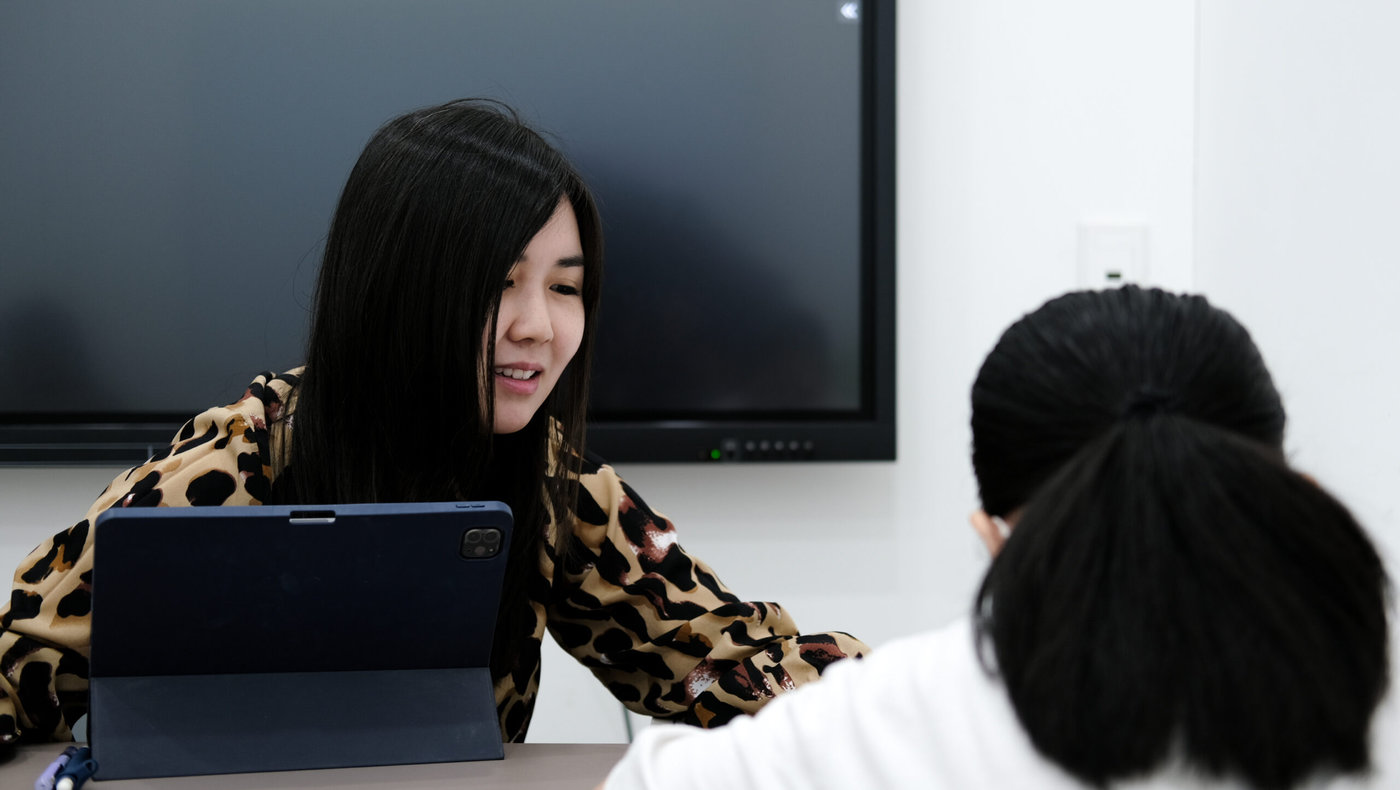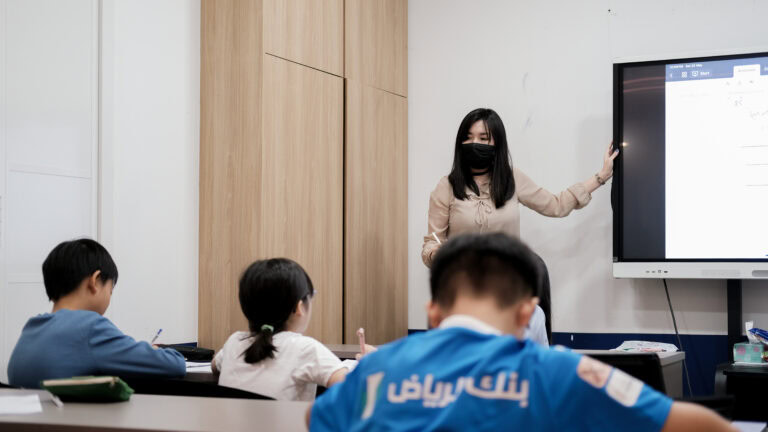Compared to the 2022 PSLE Math Paper 2, the 2023 PSLE Math Paper 2 was easier for the most part. Although there was a greater percentage of Area and Perimeter question types that tested students on their visual spatialisation abilities, students who are less spatially gifted can also score well in these sections just by using the techniques they have learnt. These techniques include rearranging and forming the components of a complex shape to make more sense of the shapes in the question, or to solve the question in fewer steps. Students may also form equations based on the components of a complex shape and solve from there. We picked out 6 questions from the Paper 2 and let us take you through an in-depth step-by-step solution to these questions.
Question 9
TTA students have been trained to spot certain phrases that will help them to identify the question type. This enables them to apply the technique that they have learnt so that they can solve the questions in the most time-efficient manner.
As soon as students see the phrase “40% of the remainder”, they will recognise it as a fraction-of-fraction question type and draw the drop-down model. To keep the numbers in the question small, students can change the percentages in the question to fractions.
75% will therefore become 3⁄4 and 40% will become 2⁄5 .
Peggy starts off by spending 3⁄4 of her money on a calculator. This means that she had 4u of money and she spent 3u of it on a calculator and had 1u left.
She then spent 2⁄5 of the remaining 1u on a book. We drop down the part of the model labelled 1u and call it 5 parts, since the denominator of the fraction is 5.
Of the 5 parts, she spent 2p on a book and had 3p left.
3p is therefore equal to $6.90.
Do you realise that 1u and 5p are essentially the same thing? In that case, we make 1u and 5p the same number by multiplying 1u by 5 to change it to 5p.
Since we multiplied 1u by 5, we need to multiply all units in the model by 5.
After going through the process, we can now see that Peggy had 20p of money at first.
3p -> $6.90
1p -> $2.30
20p -> $46
The answer is therefore $46.
Question 11
This is an interesting question that requires students to find the pattern.
The rods are in between the straws as well as the sides of the grid.
If the figure is 2 rods long, and 3 straws wide, this means that there will be 2 layers (horizontally), and 3 + 1 = 4 layers (vertically). Therefore, there will be 2 × 4 = 8 rods.
As for straws, if the grid is 2 rods high, this means that there will be 2 + 1 = 3 layers of straws.
If this grid is 3 straws wide, there will therefore be 3 × 3 = 9 straws.
Let’s apply this pattern that we have found to part (a).
In a grid that is 3 rods long and 4 straws wide, there will be 3 layers (horizontally) and 4 + 1 = 5 layers (vertically). Therefore, there will be 3 × 5 = 15 rods.
As for straws, if the grid is 3 rods high, this means there will be 3 + 1 = 4 layers of straws.
If this grid is 4 straws wide, there will be 4 × 4 = 16 straws.
Therefore, the answer to part (a) is 15 + 16 = 31
In part (b), the grid is 4 rods long and 52 straws wide. All we need to do is to apply the pattern we have found to it.
If the grid is 4 rods long and 52 straws wide, this means that there will be 4 layers (horizontally) and 52 + 1 = 53 layers (vertically). Therefore, there will be 4 × 53 = 212 straws.
As for straws, if the grid is 4 rods high, this means there will be 4 + 1 = 5 layers of straws.
If this grid is 52 straws wide, there will be 52 × 5 = 260 straws.
The answer to part (b) is therefore 212 + 260 = 472
Question 12
Whenever a question asks for the perimeter of the figure, it is a good idea to pick out the lines that form the perimeter so that no line is left out.
As colour coded in purple, blue, and yellow, the purple lines form the circumference of a circle, and so do the blue lines and yellow lines respectively.
To get the perimeter of the shaded part, we find the perimeter of the 3 circles which each has a radius of 7cm.
22⁄7 × 14cm = 44cm
44cm × 3 = 132 cm
Another trick to solving questions quickly would be to apply the rearrange and form method. The spaces in between the circles are actually made up of 4 L‑brackets. When rearranged around a circle, these 4 L‑brackets and the circle form a square. Through some simple shifting, you will see that the shaded parts can be rearranged to form 2 squares and 1 circle.
Area of 1 square -> 14cm × 14cm = 196cm2
Area of 1 circle -> 22⁄7 × 7cm × 7cm = 154cm2
Shaded part -> 196cm2 + 196cm2 + 154cm2 = 546cm2
Question 13
This has been a popular volume question type in recent years and TTA students have been taught the following technique when it involves an unknown height of the water level.
From the question, we know that the total volume of water in both tanks is 21 400 cm2. We also have the base areas of both tanks. The height of the water level is unknown but what we do know is that the height of the water level in tank Y is 5cm higher. Therefore, let the height of the water level in Tank X be represented by 1u, and the height of the water level in Tank Y be represented by 1u + 5.
The volume of water in Tank X is -> 20 × 10 × 1u = 200u
The volume of water in Tank Y is -> (30 × 20 × 1u) + (30 × 20 × 5)
= 600u + 3000
Total volume in both tanks is -> 200u + 600u + 3000
The total volume of water in both tanks is equal to 21 400cm3.
Let’s form an equation and solve for 1u, which represents the height of the water level in Tank X.
200u + 600u + 3000 = 21 400
800u + 3000 = 21 400
800u = 18 400
1u = 23
The height of the water level in tank X is therefore 23cm.
For part (b), let’s focus on Tank Y.
If the height of the water level in tank X is 23cm, then the height of the water level in tank Y is 23cm + 5cm = 28cm.
Volume of water in Y -> 30cm × 20cm × 28cm = 16800 cm3
Half of tank Y -> 16800 cm3 – 3300 cm3 = 13500 cm3
Capacity of tank Y -> 13500cm3 × 2 = 27000 cm3
Height of tank Y -> 27500 cm3 ÷ 600 cm2 = 45 cm
The height of tank Y can also be found by taking 3300cm3 ÷ 600cm2 = 5.5cm to find out the decrease in height. The height of the water level when tank Y is half-filled is 28cm – 5.5cm = 22.5cm. Hence, the full height of Tank Y is 22.5cm × 2 = 45cm.
Question 16
This is a gap and subject question type. Students have 1 rule to remember: The number of gaps is always 1 less than the number of subjects.
This means that if there are 5 lampposts, there will be 4 gaps. If there are 10 lampposts, there will be 9 gaps.
24 pins were placed at an equidistance apart along the rectangular board, and we want to find out how many pins there are along the length.
First of all, we need to eliminate the four corners so that we do not double count them.
24 – 4 = 20
We are left with 20 pins now that we have placed a pin at each corner.
According to the figure, there are 4 pins along the breadth, with 2 pins in between the corner pins. Along 2 breadths, we will be able to place another 2 + 2 = 4 pins.
This leaves us with 20 – 4 = 16 pins
These 16 pins will then be distributed equally between the 2 lengths.
16 ÷ 2 = 8.
We will end up placing 8 pins in between the corner pins along the length.
This means that we will have a total of 8 + 2 = 10 pins along the length of the rectangular board.
Part (a) is asking for the length of the rectangular board.
If there are 10 pins, it means that there are 10 – 1 = 9 gaps.
In the question, it was stated that PQ = QR. This means that the triangular cards are isosceles triangles. If you look at the gap in between the shaded triangles, the white triangles have the same 2 equal sides as PQ and QR, this means that they will form the same angle and the longest side of the white triangle will also be 40cm.
In that case, the length of AB will therefore be 9 × 40cm = 360cm.
For part (b), it is not difficult to find the area of 1 card, but it may be tricky to figure out how many cards were placed along the lengths.
If you noticed, the cards placed along the breadths have the long side of the card sitting along the breadth. However, the cards along the lengths of the board have only the tip of the card sitting along the length.
You can think of the white triangles as the “subjects”, and the black triangles in between as the “gaps”. Since you already know that there are 9 white triangles along the length, this means that there will be 1 less black triangle than white triangles. There are 9 – 1 = 8 triangles along the length of the board.
In total, we have 3 + 3 = 6 triangles along the breadths, and 8 + 8 = 16 triangles along the lengths, which gives us 22 triangles.
Area of 1 triangle -> 1⁄2 × 40cm × 20cm = 400cm2
Total area of the cards -> 400 cm2 × 22 = 8800 cm2
Question 17
This is not a tricky question if students know the trick to it.
Let’s say that the three trapeziums in figure 2 are not touching. The total perimeter of these trapeziums would have been 96cm × 3 = 288cm.
When you combine the trapeziums, the circled parts were subtracted from the perimeter of the figure. Do you see how many PQ were removed in Figure A below?
The circled parts consist of 4 PQ.
Therefore, 4 PQ is equal to 288cm – 204cm = 84cm.
Line PQ is therefore 84cm ÷ 4 = 21cm.
For 17(b), there are a few ways to solving it but we will focus on the concept that 2 trapeziums join together to form a rectangle.
In Figure 3, the 4 trapeziums have an area of 1932cm2.
Area of 1 trapezium -> 1932cm2 ÷ 4 = 483cm2
Area of 1 rectangle -> 483cm2 x 2 = 966cm2
The breadth of the rectangle is line PQ, which you already know the length of 21cm.
Therefore, the length of the rectangle is 966cm2 ÷ 21cm = 46cm
Line RS is 46cm – 21cm – 12cm = 13cm.
Conclusion
Over the years, we see shifts in trends and the evolution of question types, and our curriculum is updated annually to reflect the changes in the MOE syllabus. We want to place our eggs in the right baskets, and have our students reap as much fruit from their labour. Our role as teachers is to help students connect the dots in the question and teach them how to make sense of information in the question and solve it in the most time-efficient manner.
At Think Teach, Math lessons are structured so that learning is a breeze and not a torture. Your child will be challenged by tricky questions and trained to solve commonly tested ones with ease. Consistency is the key here to success. With a structured approach to problem-solving, every Math question would seem familiar. Your child will no longer perceive every Math question as a daunting mountain that he/she has not conquered. As I like to say, “Practice makes perfect”. If something at first seems unfamiliar to you, keep on working at it until you know it like the back of your hand!
This article was proudly written for you by TTA’s Math Team. Our strategy in helping students achieve exam excellence is simply to expose them to every type of question that could come out for PSLE and arm them with our easy-to-apply techniques and would help them approach these questions systematically



